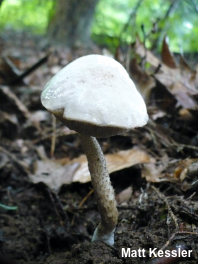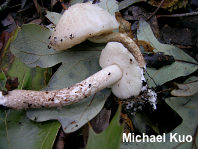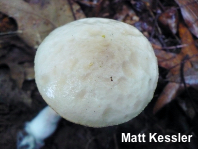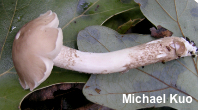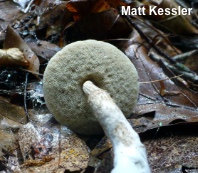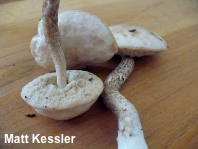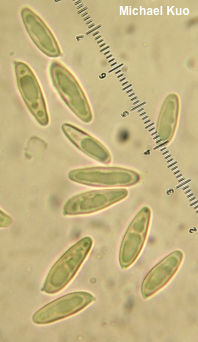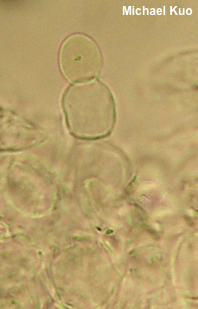| Major Groups > Boletes > Leccinum > Leccinum albellum |

|
Leccinum albellum [ Basidiomycota > Boletales > Boletaceae > Leccinum . . . ] by Michael Kuo Leccinum albellum is a slender, whitish to very pale brown species of Leccinum associated with oaks east of the Rocky Mountains. It is very similar in appearance to Leccinum holopus, although the latter species is sometimes prone to blue staining on the stem and pinkish staining in the sliced flesh. Separating the two species with confidence, however, may require either figuring out what kinds of trees were in the vicinity of your mushroom collection (Leccinum holopus is associated with birches rather than oaks)—or microscopic examination, since the pileipellis of Leccinum holopus is a cutis, but in Leccinum albellum it's an epithelium. Leccinellum albellum is a synonym. Thanks to Matt Kessler for documenting, collecting, and preserving Leccinum albellum for study; his collection is deposited in The Herbarium of Michael Kuo. Description: Ecology: Mycorrhizal with oaks and possibly also associated with other hardwoods; appearing alone or gregariously; summer and fall; widely distributed in eastern North America from the northeast to the upper Midwest and the southeastern United States, through Texas into Mexico. The illustrated and described collections are from Illinois, Missouri, and North Carolina. Cap: 3–7 cm; convex, becoming broadly convex; dry or, when young and fresh, a little tacky; bald; pale brownish to nearly white; often developing a mosaic-like, cracked appearance with old age. Pore Surface: Whitish, becoming pale brownish; not bruising; 1–3 angular pores per mm; tubes to 12 mm deep; by maturity usually depressed at the stem. Stem: 5–9 cm long; 7–12 mm thick; equal, or with a slightly tapering apex; finely scabrous with grayish to brownish or brown scabers; ground color whitish to very pale grayish (usually paler toward apex and darker below); basal mycelium white, often copious. Flesh: White to pale yellowish in places; not staining on exposure. Odor and Taste: Not distinctive. Spore Print: Olive brown. Microscopic Features: Spores 13–20 x 4–5.5 µm; narrowly fusiform; smooth; golden in KOH. Basidia to about 30 x 13 µm; clavate; 4-sterigmate. Hymenial cystidia 30–55 x 7.5–12.5 µm; variously shaped but primarily lageniform; smooth; thin-walled; hyaline in KOH. Pileipellis a trichoderm of inflated, chained elements (an epithelium) 10–25 µm wide, smooth, thin-walled, hyaline to yellowish in KOH; terminal and subterminal cells subglobose to clavate or irregular. Caulocystidia in bundles with caulobasidia; variously shaped but mostly lageniform with a long, twisted neck (also mucronate, subclavate, or irregular); up to 60 x 15 µm or longer; hyaline to grayish brown in KOH. REFERENCES: (Peck, 1888) Singer, 1945. (Singer, 1947; Smith, Thiers & Watling, 1967; Snell & Dick, 1970; Smith & Thiers, 1971; Smith, Smith & Weber, 1981; Weber & Smith, 1985; Phillips, 1991/2005; Metzler & Metzler, 1992; Both, 1993; Bessette et al., 2000; Roody, 2003; Binion et al., 2008; Kuo & Methven, 2014; Bessette et al., 2016; Woehrel & Light, 2017; Baroni, 2017; Elliott & Stephenson, 2018; Kuo & Ortiz-Santana, 2020.) Herb. Kuo 09200807, 07241101. Herb. EIU ASM 7388. This site contains no information about the edibility or toxicity of mushrooms. |
© MushroomExpert.Com |
|
Cite this page as: Kuo, M. (2020, January). Leccinum albellum. Retrieved from the MushroomExpert.Com Web site: http://www.mushroomexpert.com/leccinum_albellum.html |
